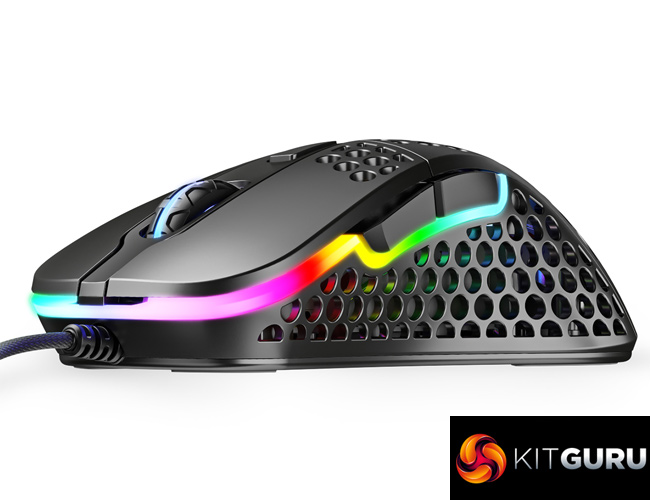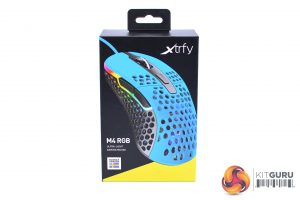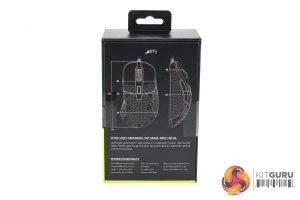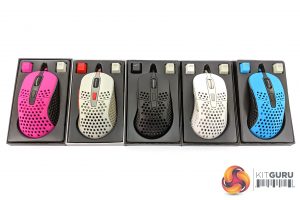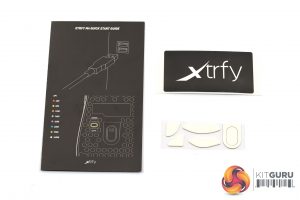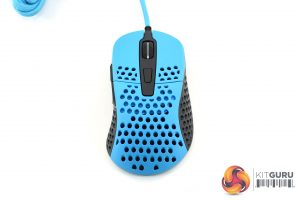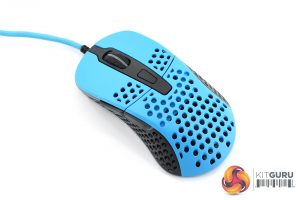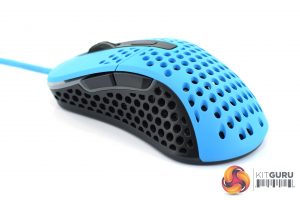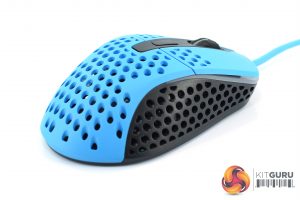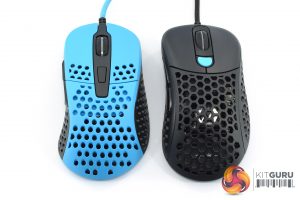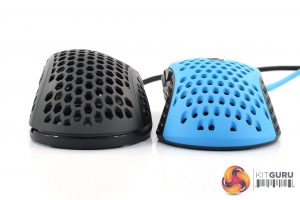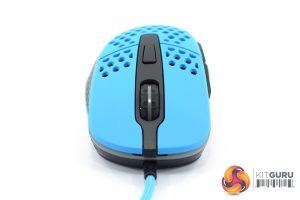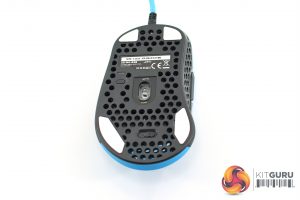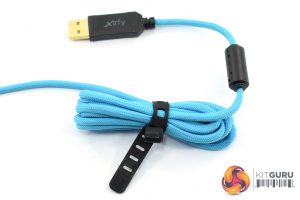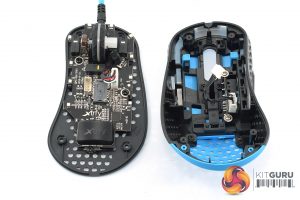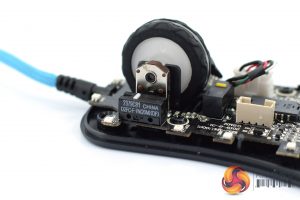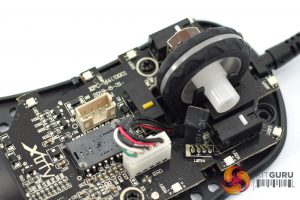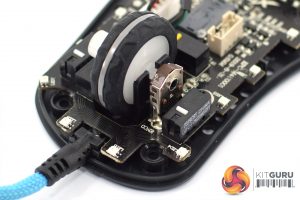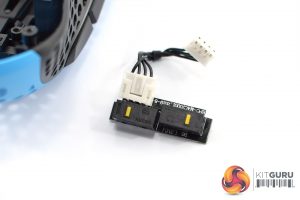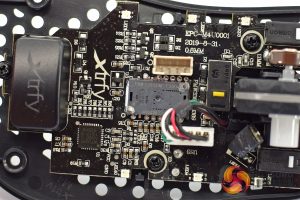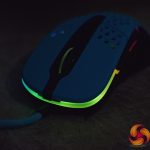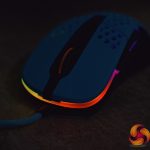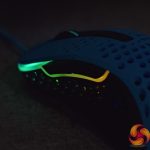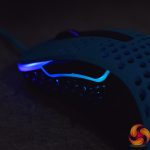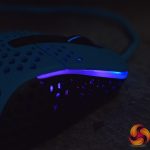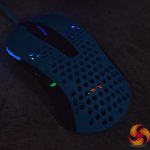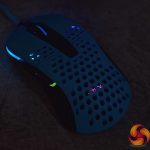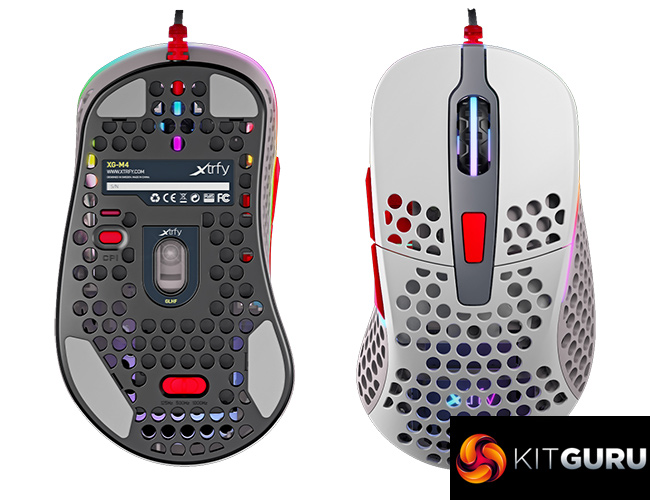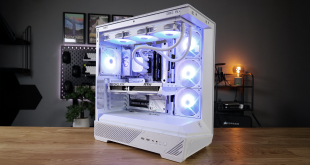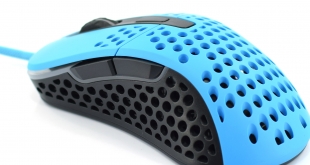
We are back with yet another ultra-lightweight gaming mouse review. After Finalmouse kickstarted this new industry trend back in 2018, we have seen a wave of lightweight mice from the likes of Glorious, Endgame Gear, Cooler Master and more. Today we assess Xtrfy's offering, in the shape of the M4 RGB. Featuring an ergonomic shape, PMW 3389 sensor and ‘EZcord' cable – for under £50 – is this the best ultra-lightweight mouse we have reviewed so far?
On top of the shape and sensor, the Xtrfy M4 also sports RGB lighting which can be controlled directly from the mouse itself, negating the need for software. Additionally, the M4 is available in five different colours – black, white, blue, pink, and ‘retro'. We have a photo of all five colours side by side on the next page if you are interested.
Specifications:
- Shape: Ergonomic, patent pending
- Sensor: Optical Pixart 3389
- LED illumination: Adjustable RGB
- Weight: 69 g (excluding cable)
- Main switches: Omron 20M(OF)
- Cable: 1.8 m Xtrfy EZcord
- Glides: PTFE
- Coating: UV coated surface
- CPI settings: 400/800/1200/1600/3200/4000/7200/16000
- Polling rate settings: 125/500/1000 Hz
- IPS: 400
- Max acceleration: 50 G
- Connection: USB
- OS: Win XP/Mac OSX 10.1 or later
- Warranty: EU/US/ASIA: 2/1/1 years
The Xtrfy M4 RGB ships in a mostly black box, with a product photo dominating the front. On the back we can see a diagram of the mouse's dimensions, as well as some key specifications.
For the purposes of this review I am photographing the blue model, however above you can see all five of the colour options. From left to right we have: pink, retro, black, white, and blue. It's worth pointing out that the retro model does actually cost more than the others – currently OCUK sells the retro option for £57.95, whereas the others are all £49.99.
I also like that Xtrfy has included two keycaps as part of the M4 bundle – one of which is a grey/beige colour emblazoned with the letters ‘GG', while the other cap matches the colour of your chosen mouse and carries the Xtrfy logo. It's a small thing but a nice touch from Xtrfy. Additionally, a quick start guide, Xtrfy sticker and replacement set of mouse feet also come included in the box.
Looking closer at the mouse itself, it's clearly an ergonomic design and it shares some design similarities with the Zowie EC series. That said, I wouldn't call this an ‘EC clone' as there are a few areas of difference which we will get to below. As a general overview, though, we can see a significant outward curve towards the back on the left hand side of the mouse, while the right side also flares outwards slightly.
In terms of dimensions, the M4 measures 120 x 68 x 39mm (L x W x H). That width measurement is taken from the very back of the mouse, so the actual width of the M4 is 60mm where you would grip it. At 120mm long, too, you can tell this isn't a huge mouse – it's actually the same exact length as the Zowie EC2-B, so I'd class it as ‘medium size'.
We can also see Xtrfy has covered both sides of the mouse in holes, when some ultra-lightweight mice leave the sides as solid panels. The holes themselves are also circular instead of the honeycomb style we have seen on multiple other ultra-lightweight mice.
As this is a mouse exclusively for right-handers, there are two side buttons on the left of the M4, but none on the right side.
Above we can see a side-by-side comparison of the M4 RGB with the Sharkoon Light2 200 – itself a Zowie EC clone. There are of course broad similarities in terms of the overall shape, but again the curve on the M4's left-hand side is much more pronounced than the Light2. Additionally we can also see the hump towards the back of the M4 is much flatter; it still slopes upwards towards the left-hand side but not nearly as much as the hump on the Light2.
At the front, we can see the two primary buttons which are separate from the main shell of the M4. These don't have any comfort grooves built in. In between the buttons sits the rubber scroll wheel, and behind that is another very low-profile button – ordinarily this would change DPI, but with the M4 this is dedicated to adjusting the RGB lighting.
As for the underside of the mouse, this is again filled with more holes. We can also see four small PTFE feet, as well as a small slider which can adjust polling rate from 125Hz, to 500Hz, to 1000Hz. Additionally, to the left of the sensor lens we find another small button – this is for changing DPI, with a total of 8 stages to choose from. These are: 400, 800, 1200, 1600, 3200, 4000, 7200 and 16000.
The cable is known as the Xtrfy ‘EZCord', it measures 1.8m and it's another cable designed to be paracord-esque in terms of its flexibility and lightness. The colour of the EZCord also varies to match whichever colour option you went for, which is a nice touch.
Taking the mouse apart to look at the internals, we can get a look at the switches used for the primary buttons – as expected, these are Omron D2FC-F-7N(20M).
Both the scroll wheel click and the RGB button use Huano yellow switches, while the scroll wheel encoder is a brown F-Switch model.
The side buttons are housed in the top shell of the M4 so connect to the PCB via a short cable, and once more these are Huano yellow switches. The last thing to mention is the PMW 3389 sensor in the middle of the PCB.To test the M4, I used it as my daily driver for almost two weeks. We break down testing into four main sections: on-board controls, lighting, build quality and comfort, and performance.
On-board controls
Usually we look at a mouse's software first, but as the M4 has no software, Xtrfy has built a number of controls into the mouse itself which are accessible by pressing various combinations of buttons.
All of the controls are detailed in the M4's quick-start guide – PDF HERE – but to give you some examples of what controls are available:
- Pressing the RGB button + right click changes the colour of the LEDs.
- Pressing the RGB button + side buttons increases or decreases LED brightness.
- Pressing the RGB button + left click adjusts the speed of the RGB effect.
And that is it. I do like having the option to tinker with the RGB control without the need for software, and I can also understand Xtrfy's decision to not include software – it's cheaper from a development perspective as no time has to be spent developing the software, and it also means there's nothing to download or potentially bug-out in use.
Then again, there's a lot of functionality missing without any software. There's no control over the DPI stages – you have to use all 8 and they can't be adjusted – while there is also no control over lift-off distance, you can't create different profiles and so on. For me, having a lightweight software suite only helps, and at the very least, if a mouse has on-board memory, users can download it, adjust their settings, save them to the on-board memory, and then uninstall the software. With the M4, however, we don't get that option.
Lighting
As for the lighting itself, there's a fairly long LED strip at the front of the mouse which extends about halfway down the sides of the M4. The Xtrfy logo positioned on the PCB is also an RGB zone, so you can see it through the holes in the top shell. While the overall control of the RGB effects is limited to whatever you can adjust via the on-mouse controls – effects include static colour, breathing, colour wave, colour cycle – I do think it's quite a tasteful implementation. The LEDs are nice and bright while the colours look good. I am also a big fan of the RGB lighting peeping through the holes in the mouse's shell. For a mouse like the M4, the RGB is certainly not a cause for complaint.
Build quality and comfort
Overall build quality of a sub-70g mouse is always going to be an interesting area, particularly when the entire shell is filled with holes. That being said, I have been very impressed by how robust and well-built the M4 is.
For starters, I couldn't detect any creaking or flexing when applying pressure to the top of the shell – there was no give in the plastic even when pushing down unreasonably hard with both thumbs, which is certainly more than can be said for some other ultra-lightweight mice I have tried recently.
Additionally, there was no audible rattle from the M4 when I picked it up and gave it a good shake. The primary buttons exhibit very little lateral movement, too – there is some movement, but this is only noticeable when deliberately pushing the buttons side to side, in normal use this was not an issue at all.
As with all other ultra-lightweight mice I have tested, you can actuate the side buttons by squeezing the sides of the M4. However, the amount of force required to do so is unreasonably high so I can say with confidence that accidental actuation would not happen during normal use, it's only when deliberately squeezing the mouse with considerable force that it becomes noticeable.
Moving onto comfort and grip styles, I personally got on really well with the M4. To be clear, the distinctive shape means this won't be for everyone, but if you like other ergonomic mice like the Zowie EC series, Logitech G403 or SteelSeries Rival, the M4 could be right up your street.
I typically use a claw grip and while that is no problem with the M4, I found myself using it with more of a claw/palm hybrid grip – the outward curve on the left-hand side of the mouse definitely lends itself to sitting in your palm. True palm grip is also possible and is comfortable, but due to the size of the M4 this is only going to be an option for those with smaller hands. Mine measure 18.5x9cm and I was just on the limit for using this mouse comfortably with a palm grip.
Fingertip should also be OK for most users, it's possible the curve on the left-hand side may get in the way for some people, but overall the M4's shape caused me no problems and it's certainly worth trying if you typically prefer ergonomic designs.
Performance
Starting our performance testing section with the primary buttons, these are very good indeed. The click is light and crisp, with just a bit of post-travel – I'd say slightly more than the G403, which has the best primary buttons I've ever used, but this is right up there in terms of overall tactility and speed at which you can spam the buttons.
The Huano yellow switches are also excellent for the side buttons. I'd not used Huano yellows before and it's a very light switch, which is my personal preference, so I was again able to repeatedly mash these side buttons at high speed. The only negative aspect of the side buttons is a small amount of pre-travel, but it didn't cause me any issues in-game.
As for the scroll wheel, this is another strong area for the M4. Scrolling is tight and with well-defined steps, there's no lateral movement from the wheel and it requires a medium amount of force to click down. There's really nothing to complain about there.
Moving onto sensor performance then, as expected when seeing that the PMW 3389 that has been deployed with the M4, I had no issues in terms of tracking. Of the 8 DPI stages, I was most comfortable at stage 3 – 1200 DPI – and there I found movements to be as precise and controlled as with any other PWM 3389-based mouse. There's also no noticeable acceleration or jitter either, so apart from the fact the user can't set their own DPI setting, this is as good as it gets.
Lift-off distance (LOD) is another area to touch on, and things are very simple here – there's no way to adjust LOD, and the mouse stops tracking from just 1 DVD high. I've always kept LOD as low as possible so personally I think this is great. However, should you want to install third-party mouse feet, or if you like a higher LOD, then that is just not possible due to the lack of software.
Finally we come to the cable. Xtrfy calls this the ‘EZCord' and overall it is certainly a decent cable – I'd probably put it on the same level as the Model O in terms of flexibility. There is just a bit of initial stiffness which I tried to work out by flexing the cable backwards and forwards, and that did seem to help a bit. However, for me the Cooler Master MM711 is the clear leader with its ‘ultraweave' cable, so while I'd definitely class the EZCord as ‘good', it is still not ‘the best'.It's been a while since I tried a product from Xtrfy, but I have really enjoyed using the Xtrfy M4 RGB mouse over the last two weeks.
We've seen a number of ultra-lightweight gaming mice now, but it's always good to have options and the M4 is certainly setting itself apart with its distinctive shape. I found this very comfortable to use with a palm/claw grip hybrid, while its medium size should make it a good fit for a lot of people. Due to the ergonomic design, however, the M4 won't be for everyone, but if you know you like this sort of shape I'd definitely recommend giving it a go.
For a mouse weighing 69g, the M4 is also very well built. There's no rattle, no creaking or flexing, and lateral movement for the mouse buttons is barely worth mentioning. Overall I'd say this is the most solid-feeling ultra-light gaming mouse I have used in the past year.
It's also got high quality primary buttons, great side buttons and another top performing scroll wheel. We all know what we're getting with the PMW 3389 sensor, too, so overall the M4 does the fundamentals very well indeed.
For me, there are two main areas of improvement. First is the lack of software – as I explained on the previous page, I can see why Xtrfy has taken this route, but in my view the end-user is missing out on a fair bit of functionality that software can offer.
The second area to improve would be the cable. To be clear, I still think is a good cable but Cooler Master has really set the standard here with the MM711's ultraweave cable. In comparison, the M4's EZCord just feels a little stiff and heavy.
For £50 though, the M4 is a great buy and I am going to continue using it as my daily driver. If you want an ergonomic, lightweight mouse, the M4 RGB does a lot of things right for a good price.
You can buy the Xtrfy M4 RGB for £49.99 from Overclockers UK HERE. For the full range of colours, click HERE.
Discuss on our Facebook page HERE.
Pros
- Distinctive but very comfortable shape.
- Very well built considering the weight.
- Just 69g.
- Very good primary and side buttons.
- Great scroll wheel.
- PMW 3389 sensor.
Cons
- Cable isn't quite up to the standard of the MM711.
- No software.
KitGuru says: The Xtrfy M4 is a great mouse for just £50. I'd love to see the ‘M5' ship with an even better cable and dedicated software.
 KitGuru KitGuru.net – Tech News | Hardware News | Hardware Reviews | IOS | Mobile | Gaming | Graphics Cards
KitGuru KitGuru.net – Tech News | Hardware News | Hardware Reviews | IOS | Mobile | Gaming | Graphics Cards


